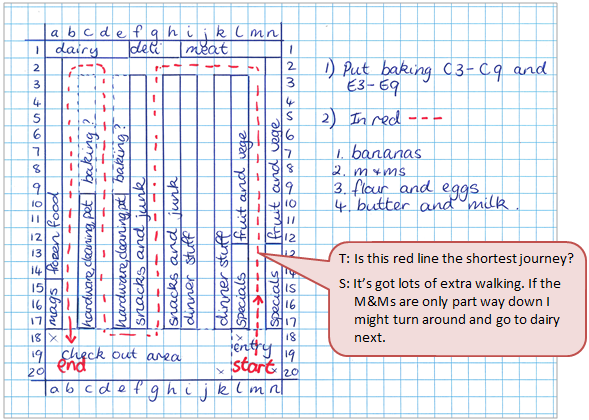Banana Cake
The purpose of this activity is to engage students in using grid references to solve a problem.
This activity assumes the students have experience in the following areas:
- Following and giving grid references to find locations and positions.
- Using coordinate systems to organise space.
The problem is sufficiently open ended to allow the students freedom of choice in their approach. It may be scaffolded with guidance that leads to a solution, and/or the students might be given the opportunity to solve the problem independently.
The example responses at the end of the resource give an indication of the kind of response to expect from students who approach the problem in particular ways.

A supermarket has its shelves laid out in a plan that uses a battleships style grid reference based on letters A to N across and 1 to 20 down.
It has stock in the following places:
Dairy A1-E1,
Frozen food A2-A14,
Dinner Ingredients I3-I17 and K3-K17,
Deli F1-H1,
Meat I1-N1,
Fruit and Vegetables L3-L12 and N2-N12,
Specials L13-L17 and N13-N17,
Snacks and Junk F3-F17 and H3-H17,
Magazines A15-A17, Hardware,
Cleaning and Pet food C10-C17 and E10-E17.
The entrance space makes a rectangle with L18 and N20 being opposite corners.
The check-out area makes a rectangle with A18 and K20 being opposite corners.
There is also shelf space for baking products.
- Suggest grid references for where the baking products (including eggs) will be located.
- If you wanted to walk the shortest distance in the supermarket to get the following ingredients needed for a banana cake, what order would you purchase these ingredients in? Butter, flour, milk, eggs, bananas and M&Ms.
The following prompts illustrate how this activity can be structured around the phases of the Mathematics Investigation Cycle.
Make sense
Introduce the problem. Allow students time to read it and discuss in pairs or small groups.
- Do I understand the situation and the words? (Students may need support to understand the meaning of a grid system. They might recognise grid systems on maps as an example.)
- What are the important words and symbols? (The use of grid references, such as L3 and A17 to specify area in the grid may require some explanation.)
- Does this look/sound like a problem I have worked on before?
- Where else in my life/the world can I see this happen?
- What will my solution look like? (The solution will be a suggestion for where to locate the baking products with a rationale for doing so. It will also suggest an order for gathering the banana cake ingredients that minimises distance.)
Plan approach
Discuss ideas about how to solve the problem. Emphasise that, in the planning phase, you want students to say how they would solve the problem, not to actually solve it.
- What strategies are likely to be useful to solve this problem?
- What maths knowledge and skills will I need?
- How will I record my working so what I have done is easy to see?
- Do I expect a pattern in the layout of the supermarket sections? What pattern is that?
- How is the pattern likely to be helpful?
- What tools (digital or physical) could help my investigation? (Some form of pre-printed grid system will be useful.)
Take action
Allow students time to work through their strategy and find a solution to the problem.
- Am I recording in a systematic way?
- Are there any patterns that I can see?
- How might I describe the patterns and why they occur?
- Does the pattern help me to answer the question?
- How does my strategy help me locate the best place for the baking section?
- Why have I located the baking section there?
- How will I know if I have the gathering path with the shortest distance?
Convince yourself and others
Allow students time to check their answers and then either have them pair share with other groups or ask for volunteers to share their solution with the class.
- What is the solution? Does the solution meet the requirements?
- Is my working clear for someone else to follow?
- How would I convince someone else I am correct, especially that I found the shortest path?
- Could I have solved the problem in a more efficient way?
- What connections can I see to other situations, why would this be?
- Which ideas or tools worked well in my investigation?
- What maths ideas did I Iearn, that I can apply to other situations?
Examples of work
Work sample 1
The student creates a grid system, locates the product sections correctly from the information, and uses the grid to solve the problem.
Click on the image to enlarge it. Click again to close.
Work sample 2
The student creates a grid system, locates the product sections correctly from the information, and uses the grid to solve the problem.

